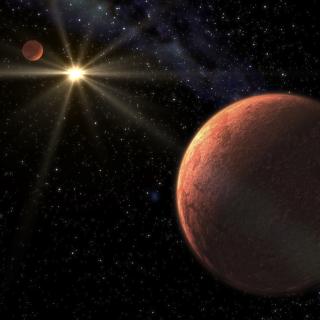Bibcode
Zapatero Osorio, M. R.; Béjar, V. J. S.; Martín, E. L.; Gálvez Ortiz, M. C.; Rebolo, R.; Bihain, G.; Henning, Th.; Boudreault, S.; Goldman, B.; Mundt, R.; Caballero, J. A.; Miles-Páez, P. A.
Referencia bibliográfica
Astronomy and Astrophysics, Volume 572, id.A67, 6 pp.
Fecha de publicación:
12
2014
Revista
Número de citas
18
Número de citas referidas
18
Descripción
We report on the near-infrared (JHK-bands) low-resolution spectroscopy
and red optical (Z-band) photometry of seven proper-motion, very
low-mass substellar member candidates of the Pleiades cluster with
magnitudes in the interval J = 17.5-20.8 and K = 16.1-18.5 mag. Spectra
were acquired for six objects with the LIRIS and NIRSPEC instruments
mounted on the 4.2-m William Herschel and the 10-m Keck II telescopes,
respectively. Z-band images of two of the faintest candidates were
collected with the ACAM instrument on the WHT. The new data confirm the
low temperatures of all seven Pleiades proper motion candidates. From
the imaging observations, we find extremely red Z - J and Z - K colors
that suggest that the faintest target, Calar Pleiades 25, has a Galactic
rather than extragalactic nature. We tentatively classify the
spectroscopic targets from early-L to ~T0 and suggest that the L/T
transition, which accounts for the onset of methane absorption at 2.1
μm, may take place at J ≈ 20.3 and K ≈ 17.8 mag in the Pleiades
(absolute values of MJ ≈ 14.7 and MK ≈ 12.2
mag). We find evidence of likely low-gravity atmospheres based on the
presence of triangular-shape H-band fluxes and the high flux ratio K/H
(compatible with red H - K colors) of Calar Pleiades 20, 21, and 22,
which is a feature also seen in field low-gravity dwarfs. Weak K i
absorption lines at around 1.25 μm are probably seen in two targets.
These observations add support to the cluster membership of all seven
objects in the Pleiades. The trend delineated by the spectroscopic
sequence of Pleiades late-M and L dwarfs resembles that of the field.
With masses estimated at 0.012-0.015 M⊙ (solar
metallicity and 120 Myr), Calar Pleiades 20 (L6±1), 21
(L7±1), and 22 (L/T) may become the coolest and least massive
Pleiades members that are corroborated with photometry, astrometry, and
spectroscopy. Calar Pleiades 25 (<0.012 M⊙) is a firm
free-floating planetary-mass candidate in the Pleiades.
Appendix A is available in electronic form at http://www.aanda.orgThe
final reduced spectra (in FITS format) are only available at the CDS via
anonymous ftp to http://cdsarc.u-strasbg.fr
(ftp://130.79.128.5) or via http://cdsarc.u-strasbg.fr/viz-bin/qcat?J/A+A/572/A67
Proyectos relacionados

Estrellas de Baja Masa, Enanas Marrones y Planetas
Se investigan los procesos que conducen a la formación de estrellas de baja masa, enanas marrones y exoplanetas y caracterizar las propiedades físicas de estos astros en varias etapas evolutivas. Las estrellas de muy baja masa y las enanas marrones son probablemente los objetos más numerosos de nuestra Galaxia, pero no por ello están
Rafael
Rebolo López

Exoplanetas y Astrobiología
La búsqueda de vida en el Universo se ha visto impulsada por los recientes descubrimientos de planetas alrededor de otras estrellas (los llamados exoplanetas), convirtiéndose en uno de los campos más activos dentro de la Astrofísica moderna. En los últimos años los descubrimientos cada vez más numerosos de nuevos exoplanetas y los últimos avances
Enric
Pallé Bago